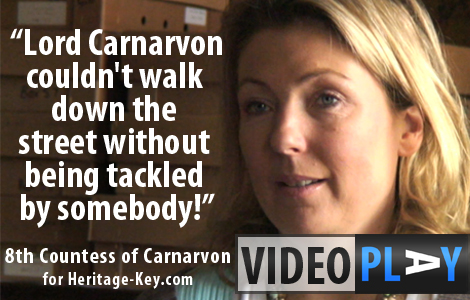 Last week we told the first part of the story of Lord Carnarvon, one of Britain’s greatest explorers: his love of cars, planes, travel, and – most importantly – his obsessive passion for finding Tutankhamun‘s treasures. But what became of the cavalier adventurer, and why is there not a single one of his finds in Britain?
Last week we told the first part of the story of Lord Carnarvon, one of Britain’s greatest explorers: his love of cars, planes, travel, and – most importantly – his obsessive passion for finding Tutankhamun‘s treasures. But what became of the cavalier adventurer, and why is there not a single one of his finds in Britain?
By the time Carter and Carnarvon had broken into the tomb of Tutankhaum, Carnarvon was already a frail man. His leg badly disfigured in a car accident in Germany, the aristocrat had only originally come to Egypt on his doctor’s advice, to escape the harsh British winter. “Carnarvon was very thin, very fragile,” says Fiona, 8th Countess of Carnarvon. “He had bad health problems.”
God knows what his doctor’s advice would have been, had Carnarvon mentioned he was playing the lead role in the world’s biggest discovery. As a weak man, the humdrum of the media and incessant run-ins with politicians was overpowering. “You’ve got Luxor overwhelmed,” the 8th Countess adds, “you’ve got journalists camping in the Winter Palace Hotel, all the rooms being sold out. Everyone claimed to know Lord Carnarvon. Everyone was related to him, everyone wanted to be there.
“They were both exhausted by the time the tomb was opened.”
With activity round the tomb reaching fever pitch, Carnarvon took a boat ride south to Aswan in late 1922. While sailing down the Nile, a mosquito bite he suffered became nasty, eventually turning septic. A cut-throat shave opened the wound up again, and the Lord caught a venomous bout of septicemia. Carnarvon battled through the winter, looking like he might fight off his illness. But several months later, hypothermia took hold, and Carnarvon died aged just 56. It might not have been the mummy’s curse, but Lord Carnarvon had still succumbed to the perils of Egypt.
Howard Carter was devastated by the loss of his great friend. The pair were perfect foils for each other: Carter the eager yet naive archaeologist, and Carnarvon the savvy and wealthy adventurer. “Great-grandfather was a soothing diplomatic influence of the highest level between Britain and Egypt, when there was quite a lot of nationalism,” says George Herbert, 8th Earl of Carnarvon. Carter’s affection for Carnarvon ran much deeper than a professional companionship. “Carter walked with a stick because he dressed like Carnarvon,” says the 8th Countess. “He aped many of his clothes because he respected him so much.”
Carter continued to work for Carnarvon’s widow Almina until 1930, when every last artefact had been removed from the tomb. Carter’s diary is riddled with arguments, incidents and tension that never occurred when Carnarvon was about. But Carnarvon, the glue that held together the press, politicians and dignitaries, had gone. And with his death came chaos and a political tug-of-war which resulted not only in all the artefacts the pair found going straight to Cairo, but in Carnarvon’s family – in particular his daughter Evelyn, receiving no compensation for their work in the Valley of the Kings.
It was a decision that came with dire consequences for the Carnarvon estate. “He spent all his money,” says the 8th Countess. “By the time he died Bretby (Hall; in Derbyshire) had gone, Somerset estates had gone, most of the houses in London had gone, and quite a lot of the land around (Highclere) had gone. He had spent off his fortune out there.”
Carnarvon never got to see King Tut’s mummy – or even the famous Golden Death Mask, forever synonymous with his achievement. Carter and Carnarvon will forever be remembered for their incredible feat finding the world’s most beautiful ancient treasure. But it also consumed both men to the point of oblivion. “In some ways the discovery of Tutankhamun was a curse for both men,” says the 8th Countess.
HD Video: Discovering King Tut – Tut’s Tomb, House of Gold
(Click here to read a transcript of this video)
Look our for our Ancient World in London series, beginning next week, when we’ll be exploring the great names of the Age of Discovery in Britain. You can even see us exploring the great archives of the Egypt Exploration Society in London, which feature the most famous archaeologists in history, here.
Fiona Carnarvon has written two books on the King Tut tomb raid: Carnarvon & Carter(buy here) and Egypt at Highclere: The Discovery of Tutankhamun(buy here). You can watch every instalment of our special Discovering Tut video series right here at Heritage Key:
- Carter & Carnarvon: The Duo that Unlocked the Tomb of Tutankhamun (Watch the Video).
- Tutankhamun’s Tomb, the ‘House of Gold’ (Watch the Video).
- Lord Carnarvon:Adventurous Life (Watch the Video)